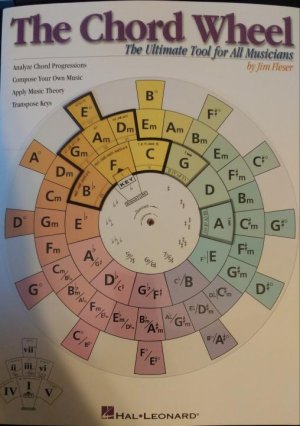Jack_TriPpEr
New member
I wrote an original song where the last chord in the progression goes out of key but sounds good, and i'd like to understand why.
The progression is: Bb - Dm - Gm - E7. Also important to note is that when I play the 1st 2 chords in arpeggiated fashion, I play an E natural note as a passing tone on each of those chords. Vs an Eb.
I've used the Hal Leonard Chord Wheel book to arrive at what I *believe* is the key / mode for the song (see pic)... While acknowledging that the combo of a Bb note, E note and G# note all being present in this progression makes it so that no key on the wheel is a 100% fit. Given all that, the closest match seems to be: D natural minor mode of F major. But like I said, even that doesn't include the E major in my progression.
The wheel says that the E chord in the key of F should be a diminished chord, diatonically speaking, whereas mine is a major. The Chord Wheel book talks about some common substitution types , e.g. making the ii or iii a major instead of a minor, and the tritone substitution for the chords in a key that have dominant 7th's instead of major 7th's. But this E7 substitution doesn't seem to fit any of these.
Does anyone have any insights into what explains how/why that E7 works? Did I identify the wrong key/mode? Or is that E7 just an "accidental" that works without anything more to explain it?
Thanks

The progression is: Bb - Dm - Gm - E7. Also important to note is that when I play the 1st 2 chords in arpeggiated fashion, I play an E natural note as a passing tone on each of those chords. Vs an Eb.
I've used the Hal Leonard Chord Wheel book to arrive at what I *believe* is the key / mode for the song (see pic)... While acknowledging that the combo of a Bb note, E note and G# note all being present in this progression makes it so that no key on the wheel is a 100% fit. Given all that, the closest match seems to be: D natural minor mode of F major. But like I said, even that doesn't include the E major in my progression.
The wheel says that the E chord in the key of F should be a diminished chord, diatonically speaking, whereas mine is a major. The Chord Wheel book talks about some common substitution types , e.g. making the ii or iii a major instead of a minor, and the tritone substitution for the chords in a key that have dominant 7th's instead of major 7th's. But this E7 substitution doesn't seem to fit any of these.
Does anyone have any insights into what explains how/why that E7 works? Did I identify the wrong key/mode? Or is that E7 just an "accidental" that works without anything more to explain it?
Thanks

